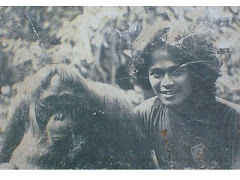
The Jakarta Post , Jakarta Tue, 07/08/2003 4:17 PM Life
Prapti Widinugraheni, Contributor, Perth, Australia
Foto : Buku Panduan Lapangan Primata Indonesia (Jatna S dan Edy Hendras)
They are monogamous and faithful until the end. Families consisting of caring parents and adorable children live within well-defined spaces in communities where they respect each other's territory.
This is the life of the silvery or Javan gibbon (Hylobates moloch), whose exemplary behavior has placed it on the ""critically endangered"" list, its fate nearing extinction.
Tree-dwelling Javan gibbons are particular in choosing the vegetation and altitude at which they live, so the slightest forest-clearing activity or human encroachment may strip them of their habitat. They are also fussy in selecting life-long partners so, understandably, courting takes ages, as does the honeymoon before baby arrives. Baby gibbons are extremely cute, cuddly and adorable and extremely attractive to poachers and black marketers.
Veterinarians Ida Yuniati and Edy Hendras, who have come to Perth Zoo to update their gibbon husbandry, say that for every gibbon poached, a mother would have likely been shot and a father have died of loneliness and depression.
There are fewer than 2,000 Javan gibbons in Java. Most, confined to patches of forest totaling about 600 square kilometers, are spread around Ujung Kulon, Gunung Halimun and Gunung Gede Pangrango national parks in West Java, Gunung Simpang nature reserve and around Mt. Slamet, up to the Dieng Plateau in Central Java.
Regulations protecting Javan gibbons can be traced to Dutch colonial laws issued in 1931 and current government rulings carry severe penalties, including imprisonment. But gibbon numbers are still dwindling.
Poor law enforcement, Edy says, is the main reason for the decline.
""I've seen gibbons and other endangered species being sold by sidewalk vendors in front of the botanical gardens in Bogor (West Java), which happens to be right next door to the (local branch of the Ministry of Forestry's) Forest Protection and Nature Conservation office,"" he says.
He does not put the blame solely on officials, who turn a blind eye, or the vendors (and officials) who break laws to make ends meet.
""In most cases, even if the protected animals were confiscated by the forestry ministry's officials, they wouldn't know what to do with them,"" says Ida. ""The officials don't have the facilities or knowledge about what course of action to take.""
Lately, a joint initiative of the government and nonprofit organizations has led to the establishment of several ""animal rescue centers"" across Indonesia, with the goal of returning endangered species to the wild. Endangered animals taken there have been confiscated or are willingly handed over by previous owners.
""But rescue centers are more like transit stations that aren't equipped to return animals to the wild. A lot of work must be done to ensure the animals can survive once they are returned and, more importantly, that they don't end up on the black market again,"" Edy says.
Not surprisingly, some of these centers have evolved into a kind of zoo packed with endangered species, ranging from eagles to crocodiles.
Rehabilitation centers, although few and far between, offer a link between animal rescue centers and their natural habitat. One such center is the Javan Gibbon Rescue and Rehabilitation Center, or Javan Gibbon Center (JGC), which Ida and Edy manage on the outskirts of the Gunung Gede Pangrango national park.
Founded by a consortium of the Ministry of Forestry, Conservation International, University of Indonesia and the Javan Gibbon Foundation, the JGC is funded by the Perth-based Silvery Gibbon Project and the Margot Marsh Foundation.
The center includes rehabilitation, education and research facilities.
The rehabilitation center, which is under construction, has three gibbons in its care. Upon completion, it will have the capacity to rehabilitate about 10 pairs of Javan gibbons simultaneously.
Ida, who heads the center's rehabilitation facility, says that after a period of quarantine and medical examination, gibbons are placed in ""bonding cages"" and ""socialization cages"", where they are expected to be reintroduced to, and rediscover their natural skills and behavior. This includes the flair for choosing that special, life-long mate.
""Most of the gibbons that have been kept as pets are in fairly good condition. Often, they are kept by couples unable to have children. But the good intentions and loving care provided by humans come nowhere close to the natural state in which they should be living,"" she says.
Ida says the rehabilitation of gibbons is more complicated than for most other species. The gibbons must be returned to the wild in wedlock to guarantee their safety and survival. Then, an appropriate home must be identified: Wild gibbons living in the forest have their territories marked, which they are unlikely to share with the new couple.
""In the wild, a young adult that has found a partner would be allotted a new territory marked by the parents. That way, other gibbons would not disturb them,"" Ida explains.
As forests in Java continue to disappear, so will habitats for gibbons and more so for newly arrived couples.
Edy, in charge of JGC's education facility, says that JGC puts heavy emphasis on educating and informing local communities and the general public about the need to preserve Javan gibbons and their habitat, particularly in the light of gibbons' character and specific penchants.
The center has stationary and mobile education units containing books, films, games and competitions designed for schoolchildren and adults. It stages talks and gatherings at local village halls to inform people of the gibbons' plight.
Located near a resort that prizes ecotourism, JGC benefits from visitors who watch wild gibbons living in their natural setting in the adjoining Gunung Gede Pangrango national park.
""Rehabilitation is just one way to stop their extinction and is aimed at returning the gibbons to the wild. It's nonsense to expect animals to breed in rehabilitation, because that's not what it's about. What we want is to see the gibbons in the wild and to keep them there -- that is tough,"" Edy says.
Prapti Widinugraheni, Contributor, Perth, Australia
Foto : Buku Panduan Lapangan Primata Indonesia (Jatna S dan Edy Hendras)
They are monogamous and faithful until the end. Families consisting of caring parents and adorable children live within well-defined spaces in communities where they respect each other's territory.
This is the life of the silvery or Javan gibbon (Hylobates moloch), whose exemplary behavior has placed it on the ""critically endangered"" list, its fate nearing extinction.
Tree-dwelling Javan gibbons are particular in choosing the vegetation and altitude at which they live, so the slightest forest-clearing activity or human encroachment may strip them of their habitat. They are also fussy in selecting life-long partners so, understandably, courting takes ages, as does the honeymoon before baby arrives. Baby gibbons are extremely cute, cuddly and adorable and extremely attractive to poachers and black marketers.
Veterinarians Ida Yuniati and Edy Hendras, who have come to Perth Zoo to update their gibbon husbandry, say that for every gibbon poached, a mother would have likely been shot and a father have died of loneliness and depression.
There are fewer than 2,000 Javan gibbons in Java. Most, confined to patches of forest totaling about 600 square kilometers, are spread around Ujung Kulon, Gunung Halimun and Gunung Gede Pangrango national parks in West Java, Gunung Simpang nature reserve and around Mt. Slamet, up to the Dieng Plateau in Central Java.
Regulations protecting Javan gibbons can be traced to Dutch colonial laws issued in 1931 and current government rulings carry severe penalties, including imprisonment. But gibbon numbers are still dwindling.
Poor law enforcement, Edy says, is the main reason for the decline.
""I've seen gibbons and other endangered species being sold by sidewalk vendors in front of the botanical gardens in Bogor (West Java), which happens to be right next door to the (local branch of the Ministry of Forestry's) Forest Protection and Nature Conservation office,"" he says.
He does not put the blame solely on officials, who turn a blind eye, or the vendors (and officials) who break laws to make ends meet.
""In most cases, even if the protected animals were confiscated by the forestry ministry's officials, they wouldn't know what to do with them,"" says Ida. ""The officials don't have the facilities or knowledge about what course of action to take.""
Lately, a joint initiative of the government and nonprofit organizations has led to the establishment of several ""animal rescue centers"" across Indonesia, with the goal of returning endangered species to the wild. Endangered animals taken there have been confiscated or are willingly handed over by previous owners.
""But rescue centers are more like transit stations that aren't equipped to return animals to the wild. A lot of work must be done to ensure the animals can survive once they are returned and, more importantly, that they don't end up on the black market again,"" Edy says.
Not surprisingly, some of these centers have evolved into a kind of zoo packed with endangered species, ranging from eagles to crocodiles.
Rehabilitation centers, although few and far between, offer a link between animal rescue centers and their natural habitat. One such center is the Javan Gibbon Rescue and Rehabilitation Center, or Javan Gibbon Center (JGC), which Ida and Edy manage on the outskirts of the Gunung Gede Pangrango national park.
Founded by a consortium of the Ministry of Forestry, Conservation International, University of Indonesia and the Javan Gibbon Foundation, the JGC is funded by the Perth-based Silvery Gibbon Project and the Margot Marsh Foundation.
The center includes rehabilitation, education and research facilities.
The rehabilitation center, which is under construction, has three gibbons in its care. Upon completion, it will have the capacity to rehabilitate about 10 pairs of Javan gibbons simultaneously.
Ida, who heads the center's rehabilitation facility, says that after a period of quarantine and medical examination, gibbons are placed in ""bonding cages"" and ""socialization cages"", where they are expected to be reintroduced to, and rediscover their natural skills and behavior. This includes the flair for choosing that special, life-long mate.
""Most of the gibbons that have been kept as pets are in fairly good condition. Often, they are kept by couples unable to have children. But the good intentions and loving care provided by humans come nowhere close to the natural state in which they should be living,"" she says.
Ida says the rehabilitation of gibbons is more complicated than for most other species. The gibbons must be returned to the wild in wedlock to guarantee their safety and survival. Then, an appropriate home must be identified: Wild gibbons living in the forest have their territories marked, which they are unlikely to share with the new couple.
""In the wild, a young adult that has found a partner would be allotted a new territory marked by the parents. That way, other gibbons would not disturb them,"" Ida explains.
As forests in Java continue to disappear, so will habitats for gibbons and more so for newly arrived couples.
Edy, in charge of JGC's education facility, says that JGC puts heavy emphasis on educating and informing local communities and the general public about the need to preserve Javan gibbons and their habitat, particularly in the light of gibbons' character and specific penchants.
The center has stationary and mobile education units containing books, films, games and competitions designed for schoolchildren and adults. It stages talks and gatherings at local village halls to inform people of the gibbons' plight.
Located near a resort that prizes ecotourism, JGC benefits from visitors who watch wild gibbons living in their natural setting in the adjoining Gunung Gede Pangrango national park.
""Rehabilitation is just one way to stop their extinction and is aimed at returning the gibbons to the wild. It's nonsense to expect animals to breed in rehabilitation, because that's not what it's about. What we want is to see the gibbons in the wild and to keep them there -- that is tough,"" Edy says.












0 komentar:
Posting Komentar